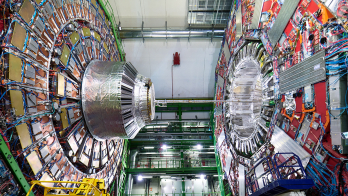An experiment at Brookhaven’s Alternating Gradient Synchrotron (AGS) has “mass-produced” doubly strange hypernuclei – exotic nuclei in which two neutrons have been replaced by L hyperons (each containing three quarks – up, down and strange).
In the AGS experiment by a collaboration of physicists from Canada, Germany, Japan, Korea, Russia and the US, a beam of negative kaons (negative charge, strangeness minus 1) produced outgoing positive kaons (positive charge, strangeness plus 1).
In these reactions an incoming negative kaon hits a nuclear proton, transforming it into a negative X particle (strangeness minus 2 – consisting of a down quark and two strange quarks). This in turn transforms into a pair of L particles, each of which can lodge in the parent or a nearby nucleus, and sometimes even in the same nucleus, identified as hydrogen-4LL, containing a proton, a neutron, and two Ls. The doubly strange hypernucleus thus resembles a deuteron onto which two Ls have been grafted. The nuclear states are identified via their weak (beta) decay patterns into pions, each pion being associated with a unit of strangeness change.
Such doubly strange hypernuclei have been reported before singly, but never in such quantities. Their production opens the door to the study of other such nuclei and of the mutual interaction of L particles. The substitution of a lambda for a neutron upsets the usual nuclear shell assignations due to the Pauli Exclusion Principle, so that the strange particles can penetrate to the nuclear core.
The simplest hypernuclei, containing a single strange particle, have been known and studied for almost half a century.





